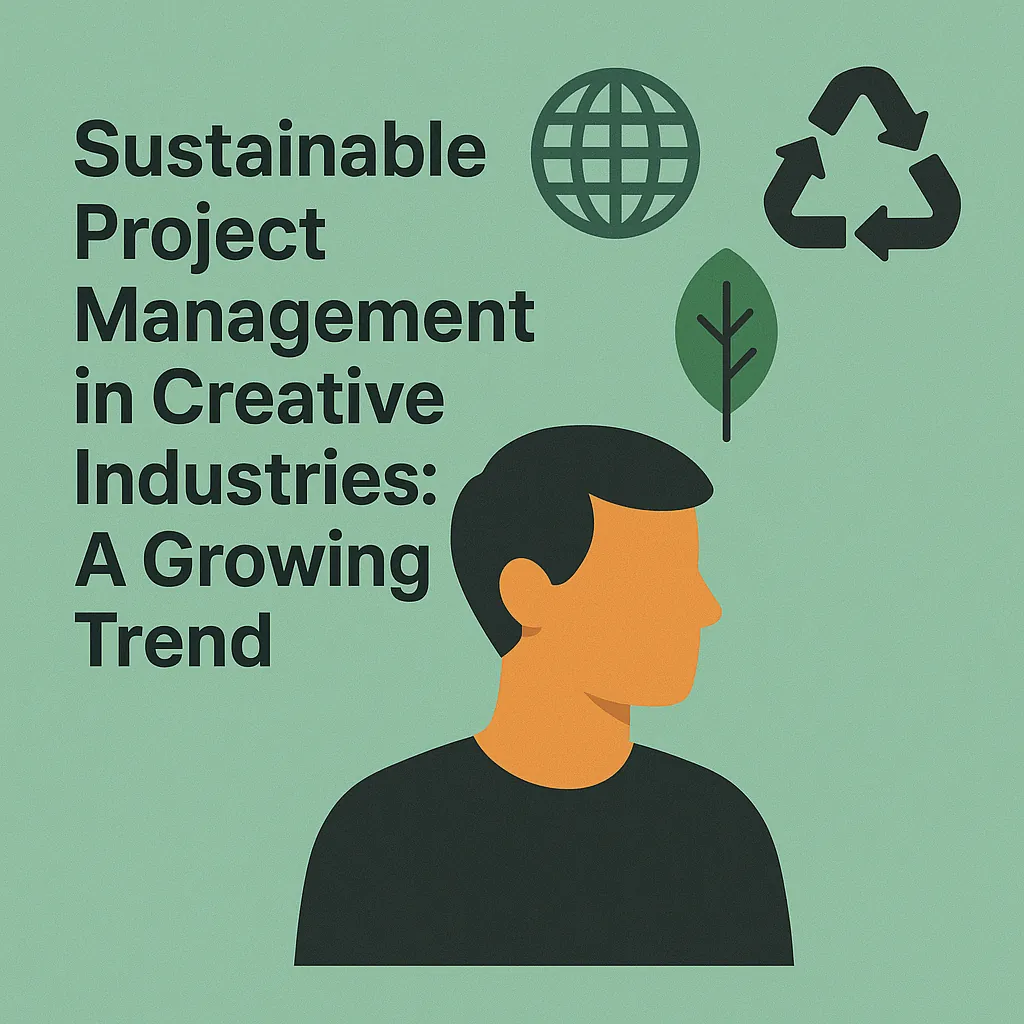Introduction
Project management plays a pivotal role in ensuring that artistic visions are transformed into tangible outcomes. Project management in these sectors encompasses the planning, execution, and oversight of projects that range from film production and advertising campaigns to art exhibitions and digital content creation. It involves coordinating diverse teams, managing resources, and adhering to timelines, all while fostering creativity and innovation.
As the global conversation around environmental and social responsibility intensifies, the importance of sustainability in contemporary project management has become increasingly evident. Creative project managers are now tasked not only with delivering successful projects but also with doing so in a manner that minimizes negative impacts on the environment and society. This shift reflects a broader recognition that sustainable practices are essential for the longevity and relevance of creative endeavors.
The integration of sustainability into creative project management is not merely a trend; it is a growing movement that seeks to align artistic expression with responsible stewardship of resources. This approach encourages project managers to consider the environmental footprint of their projects, from the materials used to the energy consumed during production. By adopting sustainable practices, creative industries can enhance their brand reputation, attract environmentally conscious clients, and contribute positively to the communities they serve. As this trend continues to evolve, it presents an opportunity for creative project managers to lead the way in fostering a more sustainable future for their industries.
Understanding Sustainability in Project Management
Sustainability in project management refers to the practice of planning, executing, and evaluating projects in a manner that meets present needs without compromising the ability of future generations to meet their own needs. This concept emphasizes the importance of integrating environmental, social, and economic considerations into the project lifecycle, ensuring that projects contribute positively to society and the planet while also being economically viable.
The Triple Bottom Line
The triple bottom line (TBL) is a framework that evaluates a project’s success based on three interconnected pillars: social, economic, and environmental factors.
- Social Factors: This aspect focuses on the impact of projects on communities and stakeholders. It includes considerations such as labor practices, community engagement, and the overall well-being of individuals affected by the project. By prioritizing social sustainability, project managers can foster collaboration and transparency, leading to stronger relationships with stakeholders and enhanced project support [2][7].
- Economic Factors: Economic sustainability involves ensuring that projects are financially viable and contribute to the economic health of the community or organization. This includes efficient resource management, cost-effectiveness, and the potential for long-term financial benefits. Sustainable project management practices can lead to reduced costs through waste minimization and resource optimization, ultimately enhancing profitability [5][9].
- Environmental Factors: Environmental sustainability emphasizes minimizing the ecological footprint of projects. This can involve using sustainable materials, reducing energy consumption, and implementing waste management strategies. By adopting environmentally friendly practices, project managers can not only comply with regulations but also appeal to a growing audience that values sustainability [6][8].
Enhancing Project Outcomes and Stakeholder Value
Integrating sustainability into project management can significantly enhance project outcomes and stakeholder value. Here are some key benefits:
- Improved Reputation: Organizations that prioritize sustainability often enjoy a better public image, which can lead to increased customer loyalty and brand strength. This is particularly important in the creative industries, where brand perception can heavily influence success [7].
- Increased Innovation: Sustainable practices encourage creative problem-solving and innovation. By challenging traditional methods and exploring new materials and processes, project managers can develop unique solutions that set their projects apart [4][8].
- Long-term Viability: Projects that consider sustainability are more likely to be resilient in the face of changing regulations and market demands. This foresight can lead to sustained success and adaptability over time, ensuring that projects remain relevant and beneficial [9].
The Role of Creative Industries in Sustainability
Creative industries play a pivotal role in shaping public perception and behavior towards sustainability. By leveraging their unique capabilities, these industries can effectively communicate sustainability messages and inspire action among diverse audiences. Here are some key points illustrating their influence and potential:
- Influencing Public Perception: Creative industries, including film, music, fashion, and design, have the power to reach wide audiences and shape cultural narratives. Through storytelling and visual representation, they can highlight environmental issues and promote sustainable practices. For instance, documentaries that focus on climate change or fashion campaigns that emphasize eco-friendly materials can significantly alter public attitudes towards sustainability [7].
- Successful Integration of Sustainable Practices: Numerous creative projects have successfully integrated sustainability into their core practices. For example, film productions are increasingly adopting green practices, such as using sustainable materials on set, reducing energy consumption, and minimizing waste. Initiatives like the “Green Production Guide” provide resources for filmmakers to implement eco-friendly practices, showcasing how the industry can lead by example [6]. Similarly, fashion brands are embracing sustainable sourcing and production methods, demonstrating that creativity and sustainability can coexist harmoniously [4].
- Driving Innovation: The creative industries are uniquely positioned to drive innovation in sustainable practices. By fostering collaboration among artists, designers, and technologists, these industries can develop new solutions that address environmental challenges. For instance, the use of digital technologies in art and design can lead to more efficient resource use and waste reduction. Additionally, creative problem-solving can inspire novel approaches to sustainability that traditional industries may overlook [5].
Challenges in Implementing Sustainable Practices
Project managers are increasingly tasked with integrating sustainability into their workflows. However, this endeavor is fraught with challenges that can hinder effective implementation. Here are some of the key barriers faced by project managers in these fields:
- Common Challenges: Project managers in creative sectors often struggle with balancing creativity and discipline. This duality can complicate the adoption of sustainable practices, as the need for innovative solutions may clash with the structured approaches typically associated with sustainability initiatives. The right balance is crucial, yet difficult to achieve, leading to potential project delays or compromises on sustainability goals [8].
- Misconceptions About Costs: A prevalent misconception is that sustainable practices are inherently more expensive. Many project managers believe that the initial investment in green technologies and sustainable materials will outweigh the long-term benefits. This perception can deter them from pursuing sustainable options, as they may prioritize immediate budget constraints over future savings and environmental impact [2][4]. In reality, while some sustainable practices may have higher upfront costs, they often lead to significant savings in the long run through efficiency and reduced waste.
- Lack of Training and Knowledge: The integration of sustainability into project management is often hampered by a lack of training and familiarity with green technologies. Many project managers may not have received adequate education on sustainable practices, leaving them ill-equipped to implement these strategies effectively. This gap in knowledge can lead to missed opportunities for innovation and improvement in project outcomes [2][5]. Furthermore, the complexity of sustainable practices can be daunting, making it essential for organizations to invest in training and resources to empower their teams.
Strategies for Integrating Sustainability in Creative Project Management
As the creative industries continue to evolve, the integration of sustainability practices into project management has become increasingly important. Here are actionable strategies for project managers to effectively incorporate sustainability into their planning and execution processes:
1. Incorporate Sustainability Goals in Project Planning
- Define Clear Sustainability Objectives: Begin by establishing specific sustainability goals that align with the overall project objectives. This could include reducing waste, minimizing carbon footprints, or promoting social equity within the project scope. Clearly defined goals will guide decision-making throughout the project lifecycle [11].
- Conduct Sustainability Assessments: Before initiating a project, conduct assessments to evaluate potential environmental and social impacts. This will help identify areas where sustainable practices can be implemented effectively [10].
2. Engage and Collaborate with Stakeholders
- Early Stakeholder Engagement: Involve stakeholders early in the project to gather insights and foster a shared commitment to sustainability. This includes clients, team members, suppliers, and community representatives. Engaging stakeholders can lead to innovative solutions and enhance the project’s sustainability profile [10][11].
- Promote Sustainable Practices: Encourage stakeholders to adopt sustainable practices by sharing knowledge and resources. This could involve workshops, training sessions, or collaborative brainstorming to identify sustainable alternatives in materials, processes, and logistics [12].
3. Utilize Tools and Resources for Sustainable Project Management
- Leverage Project Management Software: Utilize tools that support sustainability tracking and reporting. Many project management software options now include features for monitoring resource usage, waste generation, and carbon emissions, allowing project managers to make informed decisions [14].
- Access Sustainability Frameworks and Guidelines: Familiarize yourself with established sustainability frameworks and guidelines relevant to the creative industries. Resources such as the United Nations Sustainable Development Goals (SDGs) or industry-specific sustainability certifications can provide valuable guidance [13][14].
4. Foster a Culture of Sustainability
- Encourage Team Involvement: Create a culture where team members are encouraged to contribute ideas for sustainable practices. This can be achieved through regular meetings focused on sustainability, where team members can share successes and challenges [12].
- Celebrate Sustainable Achievements: Recognize and celebrate milestones related to sustainability within the project. This not only motivates the team but also reinforces the importance of sustainability in the creative process [11].
By implementing these strategies, creative project managers can effectively integrate sustainability into their projects, leading to more responsible and impactful outcomes. As sustainability becomes a growing trend in project management, embracing these practices will not only benefit the environment but also enhance the reputation and success of creative projects.
Future Trends in Sustainable Project Management for Creative Industries
As the creative industries continue to evolve, the integration of sustainability practices into project management is becoming increasingly significant. This section explores the emerging trends and future landscape of sustainable project management, focusing on the impact of technology, changing consumer expectations, and the necessity for continuous learning.
Impact of Technology and Innovation
- Emerging Technologies: The rise of artificial intelligence (AI) and cloud computing is reshaping project management practices. These technologies facilitate better data analysis and decision-making, enabling project managers to implement sustainable practices more effectively. For instance, AI can optimize resource allocation, reducing waste and enhancing efficiency in creative projects [1].
- Green Tech Integration: The creative sector is witnessing a vibrant intersection with green technology. Skills in design, development, and visual arts are being harnessed to drive sustainability initiatives. This integration not only enhances the creative output but also aligns with environmental goals, making sustainability a core component of project management strategies [7].
Evolution of Consumer Expectations
- Sustainability as a Standard: As awareness of environmental issues grows, consumers are increasingly expecting brands to adopt sustainable practices. This shift is prompting creative project managers to prioritize sustainability in their projects, ensuring that their work resonates with eco-conscious audiences. The transition from a linear to a circular economy, where waste is minimized, is becoming a key expectation among consumers [9].
- Demand for Transparency: Consumers are not only looking for sustainable products but also for transparency in how these products are created. This trend necessitates that project managers in the creative industries adopt clear communication strategies regarding their sustainability efforts, fostering trust and loyalty among their audience [9].
Importance of Continuous Learning and Adaptation
- Adapting to New Standards: The landscape of sustainable project management is dynamic, requiring project managers to stay informed about the latest sustainability practices and regulations. Continuous learning is essential for adapting to new standards and expectations, ensuring that creative projects remain relevant and impactful [5].
- Collaborative Learning: Engaging with stakeholders, including clients and community members, is crucial for fostering a culture of sustainability. By collaborating and sharing knowledge, project managers can enhance their understanding of sustainable practices and implement them more effectively in their projects [5].
Conclusion
The integration of sustainability into project management has emerged as a vital trend. As creative project managers navigate the complexities of delivering impactful projects, it is essential to recognize the significance of sustainable practices. By prioritizing sustainability, project managers can not only enhance the environmental and social outcomes of their projects but also contribute to the long-term viability of their industries.
- Significance of Sustainability: The incorporation of sustainability in project management is crucial for addressing the environmental impacts associated with creative endeavors. This includes minimizing waste, reducing energy consumption, and utilizing sustainable materials, which collectively contribute to a healthier planet and society [6][7].
- Encouragement for Adoption: Creative project managers are encouraged to embrace sustainable practices as a core component of their project strategies. By doing so, they can ensure that their projects are not only innovative and engaging but also responsible and ethical. This shift towards sustainability can lead to enhanced brand reputation and stakeholder trust, ultimately driving success in the competitive creative landscape [5][9].
In conclusion, the integration of sustainability into project management is not just a trend; it is a necessary evolution that can lead to meaningful change in the creative industries. By adopting sustainable practices, creative project managers can play a pivotal role in shaping a more responsible and innovative future.
Find out more about Shaun Stoltz https://www.shaunstoltz.com/about/.
This post was written by an AI and reviewed/edited by a human.



